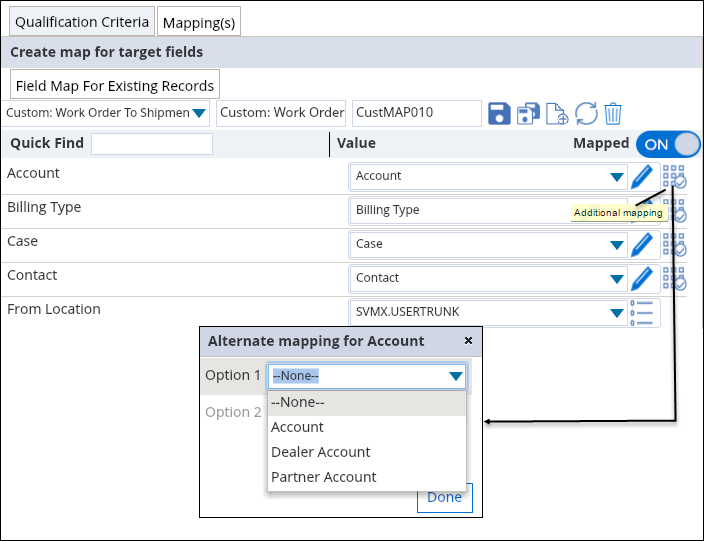Creating a Custom Field Map
1. Click + icon
2. Enter a descriptive, preferably unique name for the field map and tab to the next field; the field map id is auto-populated from the name, after replacing the spaces with '_'.
◦ You will see all the target object fields listed on the left side and compatible source object fields listed in picklists on the right side.
◦ Lookup fields are matched based on the lookup object.
◦ Text fields can be mapped to text, picklist, multi-picklist, or lookup fields.
◦ Long text area fields can be mapped to text, long text area, picklist, multi-picklist, or lookup fields.
◦ No precision/scale matching is enforced. Any errors because of mismatched field value limit/length result in failure of save operation in SFM Delivery. This failure occurs only if a specific source record’s mapped field value is too large for the target field, and not based on the source/target field length or precision.
◦ If the name and type of the fields match in source and target objects, you will also see the source object field auto-selected in the picklist in such cases.
|
|
Note: This will happen only if the global configuration setting SET001 Enable auto-suggestion on mapping (module SFM Transaction Manager, submodule SFM Transaction Designer) is set to True.
|
3. Use Quick Find to access quickly any required field, by typing any part of a field name; it triggers an inline filter which does a contains search.
4. Remove any mappings which are not required.
5. Change any mappings as required.
You can map a target field to up to two additional source fields, to be used as second and third preferences in case the primary source field value is blank.
6. After selecting the primary source field, click the Additional mapping icon (next to the pencil icon).
7. Choose one or two additional mappings as required and click Done .

◦ If you need to map any of the target fields to constants (SFM Literals or picklist values or Record Type values) instead of to source fields, click the pencil icon and select the required value from the picklist.
◦ For numeric and text fields, you can enter a hard-coded value after clicking the pencil icon. For lookup fields, you can click the pencil icon and then the lookup icon, to map a target field to a specific record.
◦ To map a user lookup field to the logged-in user's name (this will be any user who launches the SFM transaction in SFM Delivery, determined dynamically at runtime), click the pencil icon and enter 'SVMX.CURRENTUSERID'.
◦ To map a Location lookup field to the inventory location of the technician associated with the logged-in Salesforce user (this will be any user who launches the SFM transaction in SFM Delivery, determined dynamically at runtime), click the pencil icon and enter 'SVMX.USERTRUNK'.
◦ To map any child object field to the value of a header field, enter SVMX.CURRENTRECORDHEADER; Header Field API Name;.
To map a Location lookup field to the inventory location of the technician associated with the logged-in Salesforce user (this will be any user who launches the SFM transaction in SFM Delivery, determined dynamically at runtime), click the pencil icon and enter 'SVMX.USERTRUNK'. To map any child object field to the value of a header field, enter SVMX.CURRENTRECORDHEADER.<Header Field API Name>.
Note: • This literal is not valid when used for a field in the header section of an SFM transaction page layout. • This literal does not work in value maps for Source To Target All and Standalone Create type of SFM transactions, where the header record is also newly created. 3. For this literal to work, both the source and the target fields must be included in the page layout. |

8. Click the Save icon.
Note: Clicking Save saves the new field map only. It does not associate the field map with the SFM transaction. To associate, click Quick Save to save the SFM transaction. A field map can be created from the SFM Mappings configuration screen using the same steps as above. This can be done after selecting the required source & target objects using the respective Select picklists. |